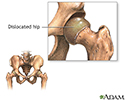Developmental dysplasia of the hip
Developmental dislocation of the hip joint; Developmental hip dysplasia; DDH; Congenital dysplasia of the hip; Congenital dislocation of the hip; CDH; Pavlik harnessDevelopmental dysplasia of the hip (DDH) is a dislocation of the hip joint that is present at birth. The condition is found in babies or young children.
-
Causes
The hip is a ball and socket joint. The ball is called the femoral head. It forms the top part of the thigh bone (femur). The socket (acetabulum) forms in the pelvic bone.
In some newborns, the socket is too shallow and the ball (thigh bone) may slip out of the socket, either part of the way or completely. One or both hips may be involved.
The cause is unknown. Low levels of amniotic fluid in the womb during pregnancy can increase a baby's risk of DDH. Other risk factors include:
- Being the first child
- Being female
- Breech position during pregnancy, in which the baby's bottom is down
- Family history of the disorder
- Large birth weight
DDH occurs in about 1 to 1.5 of 1,000 births.
##RemoveMe##
-
Symptoms
There may be no symptoms. Symptoms that may occur in a newborn can include:
- Leg with hip problem may appear to turn out more
- Reduced movement on the side of the body with the dislocation
- Shorter leg on the side with the hip dislocation
- Uneven skin folds of thigh or buttocks
After 3 months of age, the affected leg may turn outward or be shorter than the other leg.
Once the child begins walking, symptoms can include:
- Waddling or limping while walking
- One shorter leg, so the child walks on their toes on one side and not the other side
- The child's lower back is rounded inward
##RemoveMe##
-
Exams and Tests
Pediatric health care providers routinely screen all newborns and infants for hip dysplasia. There are several methods to detect a dislocated hip or a hip that is able to be dislocated.
The most common method of identifying the condition is a physical exam of the hips, which involves applying pressure while moving the hips. The provider listens for any clicks, clunks, or pops.
Ultrasound of the hip is used in younger infants to confirm the problem. An x-ray of the hip joint may help diagnose the condition in older infants and children.
A hip that is truly dislocated in an infant should be detected at birth, but some cases are mild and symptoms may not develop until after birth, which is why multiple exams are recommended. Some mild cases are silent and cannot be found during a physical exam.
##RemoveMe##
-
Treatment
When the problem is found during the first 6 months of life, a device or harness is used to keep the legs apart and turned outward (frog-leg position). This device will most often hold the hip joint in place while the child grows.
This harness works for most infants when it is started before age 6 months, but it is less likely to work for older children.
Children who do not improve, or who are diagnosed after 6 months often need surgery. After surgery, a cast will be placed on the child's leg for a period of time.
##RemoveMe##
-
Outlook (Prognosis)
If hip dysplasia is found in the first few months of life, it can almost always be treated successfully with a positioning device (bracing). In a few cases, surgery is needed to put the hip back in joint.
Hip dysplasia that is found after early infancy may lead to a worse outcome and may need more complex surgery to fix the problem.
##RemoveMe##
-
Possible Complications
Bracing devices may cause skin irritation. Differences in the lengths of the legs may persist despite appropriate treatment.
Untreated, hip dysplasia will lead to arthritis and deterioration of the hip, which can be severely debilitating.
##RemoveMe##
-
When to Contact a Medical Professional
Call your provider if you suspect that your child's hip is not properly positioned.
##RemoveMe##
References
Sankar WN, Horn BD, Wells L, Dormans JP. The hip. In: Kliegman RM, Stanton BF, St. Geme JW, Schor NF, eds. Nelson Textbook of Pediatrics. 20th ed. Philadelphia, PA: Elsevier; 2016:chap 678.
Son-Hing JP, Thompson GH. Congenital abnormalities of the upper and lower extremities and spine. In: Martin RJ, Fanaroff AA, Walsh MC, eds. Fanaroff and Martin's Neonatal-Perinatal Medicine. 10th ed. Philadelphia, PA: Elsevier Saunders; 2015:chap 107.




